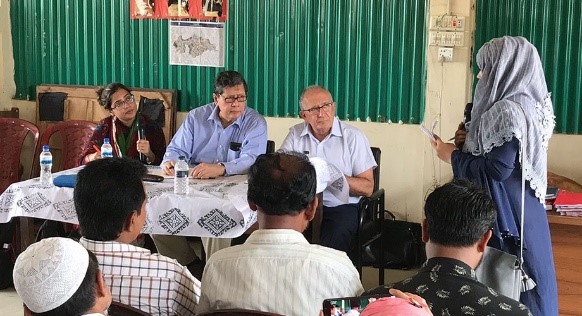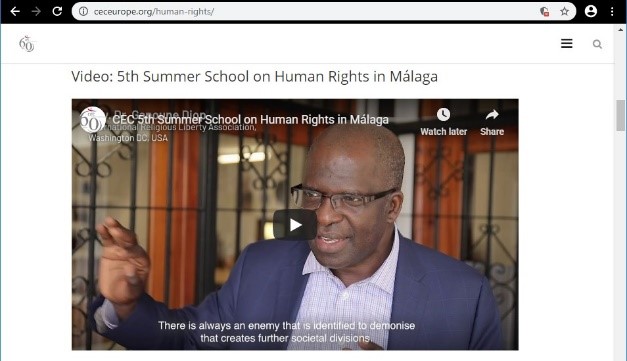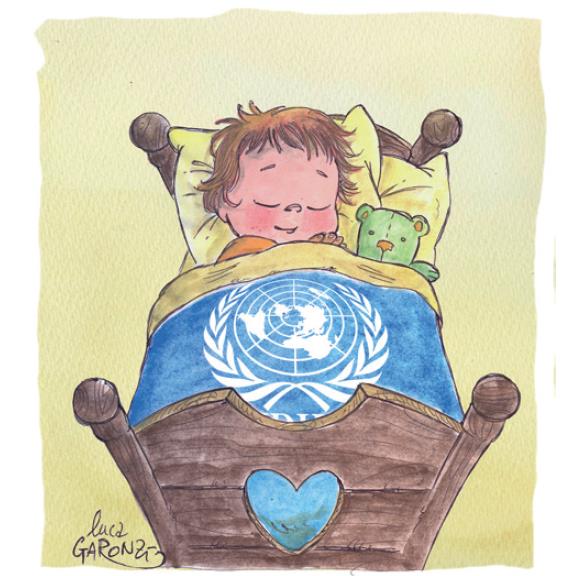Module 12: Inclusivity through education
#Faith4Rights toolkit
Full text of commitment XII
|
We commit to further refine the curriculums, teaching materials and textbooks wherever some religious interpretations, or the way they are presented, may give rise to the perception of condoning violence or discrimination. In this context, we pledge to promote respect for pluralism and diversity in the field of religion or belief as well as the right not to receive religious instruction that is inconsistent with one’s conviction. We also commit to defend the academic freedom and freedom of expression, in line with Article 19 of the International Covenant on Civil and Political Rights, within the religious discourse in order to promote that religious thinking is capable of confronting new challenges as well asfacilitating free and creative thinking. We commit to support efforts in the area of religious reforms in educational and institutional areas.- “The only possible basis for a sound morality is mutual tolerance and respect.” (A.J. Ayer) |
Context
Technological developments as well as the economic, political and environmental challenges of our times have huge repercussions on the type of education our children need and deserve. The religious education sphere is no exception, especially since faith actors are inherently educators. Their messages overlap with what children receive as education within their families and at school. An introspective critical look at the curricula of teaching religions is both necessary and beneficial. This would empower faith actors to play a constructive and balancing role with regard to the material and the spiritual ingredients of human development. Faith actors yield huge informal influence that shapes the attitudes of billions of believers. The human rights narrative, including its economic, social, cultural and environmental dimensions, offers an opportunity to enrich faith in an inter-disciplinary manner. Such enrichment of religious education curricula does not alter faith but rather enlarges its scope to embrace its full horizons. It is all about human dignity.Additional supporting documents
In support of the peer-to-peer learning on commitment XII related to education, the training file should include: the Madrid Final Document of the International Consultative Conference on School Education in Relation to Freedom of Religion or Belief, Tolerance and Non-Discrimination; and the Toledo Guiding Principles on Teaching About Religions or Beliefs in Public Schools. Furthermore, Sustainable Development Goal 4 aims at “ensuring inclusive and equitable quality education and promoting lifelong learning opportunities for all”. In 2018, UNESCO and OSCE/ODIHR jointly published guidelines for policymakers on “Addressing Anti-Semitism through education”. The UN Strategy and Plan of Action on Hate Speech(2019) includes the key commitment that “UN entities should take action in formal and informal education to implement SDG4, promote the values and skills of Global Citizenship Education, and enhance Media and Information Literacy.”
Furthermore, the Special Rapporteur on the right to education, Koumbou Boly Barry, noted the following in her 2019 report to the General Assembly: “Religious education or the teaching of the history of religion can also be used to promote animus towards different religions, which can encourage hostility, contempt or hatred. For that reason, religious architecture is often demolished in a symbolic gesture. Religious education should rather focus on the comparative history of religions and thought systems and should emphasize their mutual influences throughout history in order to deconstruct manipulative discourses portraying religions, cosmogonies or worldviews as antagonistic and irreconcilable, thus laying the groundwork for conflicts and mass crimes. This would be a way to understand religions, cosmogonies and worldviews as common cultural heritage, still to be approached with informed and critical thinking, and not just a symbol of the ‘enemy’ that during conflict turns into a target.” The Special Rapporteur's 2021 report also refers to the #Faith4Rights toolkit.
Peer-to-peer learning exercises
Unpacking: Participants break down commitment XII into different components. They also identify corresponding action points and competent stakeholders for the implementation of these actions. The main goal is to stimulate action-oriented thinking, regardless of the actual feasibility of suggested action points (individual exercise for five minutes followed by ten minutes of a full group discussion on the differences between individual listings).
Linking the dots: Just as indicated above with respect to commitment XI, also commitment XII has a horizontal link with all other 17 commitments on “Faith for Rights”. Each of these commitments is related to education in one way or another. This specific feature of the transversal nature of some commitments should be emphasized by facilitators so that participants give it due attention. This is of particular practical value given that the role of faith actors is inherently educative. It would also be useful to remind participants that the high level of intersectionality among the 18 commitments provides a concrete demonstration of the utility of a multidisciplinary approach by faith actors in fulfilling their important role within their respective spheres. This requires knowledge in many areas because, in numerous cases, faith actors are the main source of guidance to the public on substantive topics, not only limited to religion or beliefs as such. Reviewing the list of topics of fatwas by religious institutions in Muslim countries, for example, is quite revealing of the fact that ordinary people turn to religious sources on so many of the issues they confront in their daily lives and interactions.
Critical thinking: When moderating a critical discussion on the relationship between these components, facilitators should stimulate participants to also extract the implicit requirements of the identified components of commitments under discussion. For example, commitment XII presupposes a distinction between formal religious education curricula and informal ones. “Who is responsible for what” is an important implicit question. How can faith actors develop a critical eye on the teaching materials they need to handle, either their own or from other sources? Or is this the responsibility of States alone? Do participants disagree with any of explicit and implicit components of commitment XII? Can any of these elements stand alone? Are there missing elements in that commitment? (Collective exercise for 20 minutes)
Tweeting: Summarize the commitment XII within 140 characters (individual exercise for five minutes).
One possible result of this tweeting exercise could be as follows: “We commit to review the curriculums and teaching materials wherever some religious interpretations seem to encourage or tolerate violence or discrimination”.
Translating: Similar to the tweeting exercise, participants could be asked to “translate” this commitment into child-friendly language or into a local dialect. Again the idea is to stimulate discussion about the most important elements and appropriate ways of transposing and simplifying the message, without losing the substance of the commitment.
Storytelling: Participants share their reading of situations they have experienced or witnessed pertaining to this commitment and what they learned from it. In particular, was there a situation where teaching materials and textbooks included inciting or discriminatory content? Who are the different actors in their respective areas and how can they do better to ensure respect for non-discriminatory content of textbooks? Provide examples of the positive or negative role played by the media in this respect (collective exercise for 15-30 minutes).
 The facilitator could also refer to the 2018 report of the Independent International Fact-Finding Mission on Myanmar: “MaBaTha’s doctrine, as suggested by the group’s name (“Organization for the Protection of Race and Religion”), and as reflected in its publications, social media posts and public sermons, is based on the perceived need to protect, strengthen and spread Buddhism in Myanmar, and the assertion that Islam is in the process of overwhelming and marginalising Buddhism. Initially, MaBaTha focused on a more general anti-Muslim message. Its first major campaign was to propose the “Four Race and Religion Laws” and their passage into law. MaBaTha propaganda, however, has gradually shifted to a more specific anti-Rohingya and nationalist rhetoric, focusing on the “illegal Bengali” who are invading the country and thus represent a threat to national security. The MaBaTha rhetoric spread quickly through various channels. MaBaTha produced inflammatory videos, including an infamous re-enactment of the alleged rape and murder of Ma Thida Htwe in May 2012, one of the triggers of the 2012 violence in Rakhine State. These videos were distributed for free or at very low cost through pagodas, public sermons and other events. MaBaTha views were spread through schools, including monastic schools and Dhamma schools. The textbooks of the Dhamma schools for Grade 1 to 6 include sections warning against “improper associations” and “marrying the bad”, and on the concept of “Buddhist countries”. MaBaTha produced at least 10 different journals and magazines, published novels and nonfiction books, and spread messages through a variety of online platforms, including Facebook, YouTube, Twitter, blogs and websites. MaBaTha’s doctrine has been spread in popular culture by a wide network of writers, singers, businesses and other public figures who publicly support MaBaTha and have promoted its messages of hate at public events.”
The facilitator could also refer to the 2018 report of the Independent International Fact-Finding Mission on Myanmar: “MaBaTha’s doctrine, as suggested by the group’s name (“Organization for the Protection of Race and Religion”), and as reflected in its publications, social media posts and public sermons, is based on the perceived need to protect, strengthen and spread Buddhism in Myanmar, and the assertion that Islam is in the process of overwhelming and marginalising Buddhism. Initially, MaBaTha focused on a more general anti-Muslim message. Its first major campaign was to propose the “Four Race and Religion Laws” and their passage into law. MaBaTha propaganda, however, has gradually shifted to a more specific anti-Rohingya and nationalist rhetoric, focusing on the “illegal Bengali” who are invading the country and thus represent a threat to national security. The MaBaTha rhetoric spread quickly through various channels. MaBaTha produced inflammatory videos, including an infamous re-enactment of the alleged rape and murder of Ma Thida Htwe in May 2012, one of the triggers of the 2012 violence in Rakhine State. These videos were distributed for free or at very low cost through pagodas, public sermons and other events. MaBaTha views were spread through schools, including monastic schools and Dhamma schools. The textbooks of the Dhamma schools for Grade 1 to 6 include sections warning against “improper associations” and “marrying the bad”, and on the concept of “Buddhist countries”. MaBaTha produced at least 10 different journals and magazines, published novels and nonfiction books, and spread messages through a variety of online platforms, including Facebook, YouTube, Twitter, blogs and websites. MaBaTha’s doctrine has been spread in popular culture by a wide network of writers, singers, businesses and other public figures who publicly support MaBaTha and have promoted its messages of hate at public events.”
In July 2018, former High Commissioner Zeid Ra’ad Al Hussein called upon the Government of Myanmar “topromote tolerance and peaceful coexistence in all sectors of society in accordance with Human Rights Council resolution 16/18 and the Rabat Plan of Action. In addition, the Beirut Declaration and its 18 commitments on ‘Faith for Rights’ can be useful to address advocacy of hatred that incites to violence, discrimination or hostility, particularly when it is conducted in the name of religion or belief.” In January 2020, High Commissioner Michelle Bachelet added that the “#Faith4Rights toolkit, which translates this vision into 18 practical modules of peer-to-peer learning for faith actors, academic institutions and training experts, is a useful resource” with a view to empowering faith actors to optimize their impact as human rights defenders and to address incitement to hatred.
At an event in 2018 on the role of religious leaders and actors in Bangladesh, the UN Special Adviser on the Prevention of Genocide, Adama Dieng, stressed the importance of ensuring that Rohingya refugees are given opportunities to uplift themselves educationally and have access to livelihood opportunities in Bangladesh until they can return to Myanmar: “Religious leaders can play a very important role by promoting messages of peace and tolerance and by fostering dialogue between the Rohingya refugees and host communities. The Bangladeshi people demonstrated very early on its solidarity towards the Rohingya people, providing them with shelter and support when they arrived. I hope the religious leaders and actors, as well as policy makers and civil society representatives present here today will continue to show this same humanity”.
Exploring: How can the seeds of discrimination in teaching materials and textbooks be identified and redressed through religion? What should be the reaction of a religious leader concerning discriminatory content? What State role is explained in the Madrid Final Document and Toledo Guiding Principles (see above for references in the additional documents)? What are the rights of parents, legal guardians and children when it comes to religious instruction in public schools? From which age does a child attain religious maturity, for example to decide if she or he would like to attend religious instruction or not? (General discussion for 15-30 minutes)
 The facilitator could also show a short video about the Annual Summer School on Human Rights, organized by the Conference of European Churches. The participants of the 2018 summer school in Málaga were invited to discuss about theology, freedom of religion or belief and populism. Discussions included the 18 commitments on “Faith for Rights” and focused on the role of religion in Europe in the context of increasing influence of populist politics. The 2020 summer school, which was held online, provided an overview of the #Faith4Rights toolkit and its COVID-19 related exercises. Furthermore, the toolkit was presented at a webinar of the Norwegian Centre for Human Rights at the University of Oslo on “Disentangling the relationship between religion and law” (June 2020) and the University of Oxford organized a #Faith4Rights webinar on the mandate of the UN Special Rapporteur on freedom of religion or belief (July 2020) with the current and previous mandate-holders (see video).
The facilitator could also show a short video about the Annual Summer School on Human Rights, organized by the Conference of European Churches. The participants of the 2018 summer school in Málaga were invited to discuss about theology, freedom of religion or belief and populism. Discussions included the 18 commitments on “Faith for Rights” and focused on the role of religion in Europe in the context of increasing influence of populist politics. The 2020 summer school, which was held online, provided an overview of the #Faith4Rights toolkit and its COVID-19 related exercises. Furthermore, the toolkit was presented at a webinar of the Norwegian Centre for Human Rights at the University of Oslo on “Disentangling the relationship between religion and law” (June 2020) and the University of Oxford organized a #Faith4Rights webinar on the mandate of the UN Special Rapporteur on freedom of religion or belief (July 2020) with the current and previous mandate-holders (see video).
Adding faith quotes: Participants suggest additional religious or belief-based quotes to commitment XII (individual exercise for five minutes, followed by a reading from each participant of his added reference).
Inspiring: Participants underline artistic expressions they know of which capture aspects of the commitment under discussion.
Please also see the examples of a cartoon and calligraphy as well as music.


Learning objectives
- Participants appreciate developments requiring the strengthening of their role as educators for new generations that differ immensely from their predecessors in terms of connectivity, diversity and creativity.
- Participants understand that to attract the younger generation they need to speak their language and that this requires dedicated attention to education materials and methodologies from a faith perspective.
- Participants assume their responsibility as defenders of everyone’s freedom of conscience, which makes diversity part of faith.
- Participants understand that the freedom of religion or belief is a part of a larger indivisible architecture of human rights, all of which revolve around dignity, equality and freedom.
previous module ¦ overview ¦ next module >